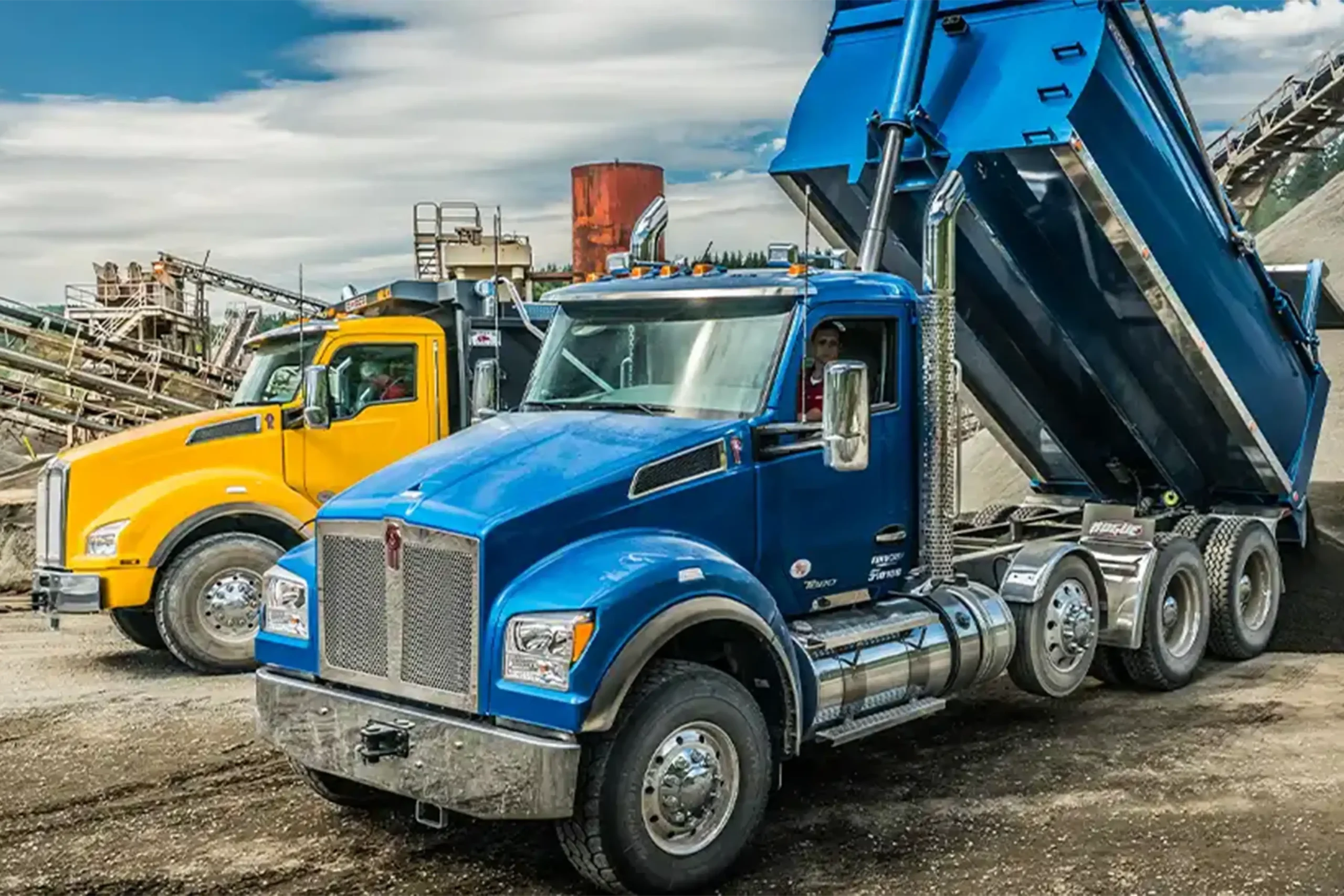The gallons add up quickly on long hauls. While fuel price forecasts indicate a general downward trend over the next few years, logistics costs are still rising.
Businesses worldwide spent a collective $12.8 trillion on logistics costs in 2024, an increase of $330 billion from 2023. Experts predict these costs will increase by a further 12% between 2025 and 2029, requiring companies to begin finding savings in other areas of their operations.
Improving your semi-truck’s fuel efficiency is one example of a cost-saving solution drivers can turn to. These tips will help you get started.
Fuel Efficiency vs. Fuel Economy
First, let’s explore what we mean by “fuel efficiency” and “fuel economy.” While many use these terms interchangeably, they mean slightly different things:
- Fuel efficiency is a general description of how efficiently a vehicle uses fuel during normal operations.
- Fuel economy refers to a specific measurement, such as miles per gallon, that represents a vehicle’s fuel efficiency.
For example, you’ll only see fuel economy represented with specific numbers, while fuel efficiency might be more descriptive.
Tips to Improve Fuel Efficiency in Your Fleet
1. Improve Your Driving Habits
This one might sound obvious, but better driving equals better fuel efficiency and economy. Risky driving can impact your fuel efficiency by using excess fuel to accelerate and decelerate, which is why adopting safer driving behaviors is key for fuel efficiency improvement.
Some essential behaviors to consider include:
- Speed control: Are you constantly switching between slow and fast? Do you have a habit of speeding?
- Stopping distances: Do you leave enough room between you and the car in front of you to brake? Are you frequently stopping quickly?
- Distracted driving: Do you have a habit of texting, eating or otherwise distracting yourself while driving? What are your biggest distractions?
Driving feedback apps can help you understand which behaviors you need to change and provide extra tips for making those adjustments.
2. Manage Tire Pressure
Regularly checking your truck’s tire pressure and keeping tires properly inflated can help you maximize fuel efficiency.
Underinflated tires increase the rolling resistance between the tires and the road, which means your engine has to work harder to move the same distance.
They can also pose a safety risk, as poor rolling resistance can increase your stopping distance and negatively impact your vehicle handling. Making tire pressure checks part of your preventive maintenance routine is one way you can ensure you complete this task.

3. Plan Routes in Advance
Route optimization is essential for getting the most out of your truck’s fuel tank. Some tips for developing the most fuel-efficient route include:
- Plan for breaks: Identifying which service stations you’ll stop at and when can help you ensure your truck is operating at peak condition throughout the drive, reducing the risk of any potential issues escalating.
- Watch the weather: Preparing for bad weather can help you avoid conditions that will reduce your fuel efficiency and add time to your trip.
- Stick to level ground: Try to avoid mountainous or hilly regions where possible, as high altitudes reduce the amount of oxygen available to combustion engines and negatively impact fuel economy.
You can use navigation apps like Waze or CoPilot GPS to determine the best route before beginning a trip. These apps also allow you to make changes to your route in real time to get around unexpected obstacles like traffic jams and accidents.
4. Minimize AC Use
Improving semi-truck fuel efficiency can be as simple as switching off the AC when it’s cool enough to go without it. In very hot weather, turning your AC on can reduce your vehicle’s fuel economy by more than 25%. This reduction is especially notable on short trips where you’re not spending long hours behind the wheel.
While driving with the windows down for long periods can reduce fuel efficiency, keeping them down when driving at slower speeds can help you save fuel by reducing the load on your engine.
5. Avoid Idling for Long Periods
Leaving your truck to idle for extended periods — even just for a quick shower at the truck stop — burns up fuel and emits harmful greenhouse gases (GHGs) into the atmosphere. And with sustainability requirements becoming stricter across various industries, it’s essential to start implementing changes that will help you save fuel.
Installing idle reduction technologies such as auxiliary power units or energy recovery systems can help you save fuel during breaks by switching to alternative power sources.
6. Maintain Consistent Speeds
Aggressive driving behaviors, such as speeding and suddenly decelerating, can impact fuel efficiency by increasing the amount of energy your truck needs to spend. Staying at one speed for long periods reduces overall energy expenditure, lowering fuel consumption and improving your efficiency.
Use cruise control when possible to ensure your vehicle remains within a reasonable speed range, and avoid sudden braking or acceleration. If you prefer not to use cruise control, it can help to simply stay aware of your speed and aim to avoid exceeding or falling below that range.
7. Keep up With Preventive Maintenance
While almost every guide about trucking will include at least one mention of preventive maintenance, it’s impossible to overstate just how important this process is for ensuring your semi-truck is working optimally.
Some key preventive maintenance steps include:
- Checking and adjusting tire pressure
- Visually inspecting the outside of the truck
- Checking wheel alignment
- Regularly inspecting brakes
- Refilling low fluid levels
- Following your manufacturer’s recommended oil change schedule
Creating a comprehensive truck maintenance checklist tailored to your specific needs can help you save valuable time and ensure you’re covering everything during your next maintenance interval.
8. Improve Truck Aerodynamics
Aerodynamics describes how objects move through the air, and it has a huge impact on fuel efficiency. The more aerodynamic your semi-truck is, the more fuel-efficient it will be.
While a more aerodynamic truck can significantly enhance fuel efficiency, the solution may require a high initial investment, depending on which one you choose. Some options for improving your truck’s aerodynamics include:
- Installing a trailer skirt between the axles to redirect airflow from the vehicle’s drivetrain
- Using mud flaps so fewer particles of dust and dirt fly up from under your tires and driving becomes safer
- Shortening the gap between the tractor and trailer to eliminate drag and use less fuel
- Driving with your windows up whenever possible to reduce drag
Our Top Picks for Fuel-Efficient Trucks
Fuel efficiency starts with your choice of vehicle, which is becoming increasingly important today. Fortunately, there are plenty of high-quality trucks that offer strong fuel efficiency. Here are our top picks:
1. The Kenworth T680
The Kenworth T680 is one of the best models for fuel efficiency in the currently available Kenworth lineup. This model is ideal for long-haul trucking as it carefully balances optimal, fuel-efficient performance with excellent driver comfort. If you’re considering purchasing a new truck for your fleet, consider the highly recommended Kenworth T680 series that features:
- Aerodynamic Design: The T680 has a sleek, streamlined shape that reduces drag, including a narrower hood and integrated fairings.
- PACCAR MX-13 Engine: This engine is optimized for fuel efficiency while providing high power output, contributing to better MPG/KPH.
- Eaton Fuller Advantage Transmission: The 10-speed automated transmission allows for smooth shifting and optimal engine performance, enhancing fuel economy.
- Predictive Cruise Control: This system adjusts the truck’s speed based on road conditions and terrain, optimizing fuel consumption during travel.
- Lightweight Construction: The use of lightweight materials helps reduce overall vehicle weight, improving fuel efficiency without sacrificing durability.
2. The Kenworth T680 Advantage
The Kenworth T680 Advantage is specifically engineered to maximize fuel efficiency while providing a comfortable yet powerful driving experience. With an aerodynamic design and advanced trucking technology, it is one of the most fuel-efficient options in the Kenworth lineup. This model features:
- Aerodynamic Enhancements: The T680 Advantage features improved aerodynamics with side extenders, a front air dam, and optimized fairings that reduce drag and improve airflow.
- PACCAR MX-13 Engine: This engine is designed for high efficiency and power, providing excellent fuel economy while maintaining performance.
- Optimized Tire Selection: The T680 Advantage can be equipped with low-rolling-resistance tires that further enhance fuel efficiency by reducing friction.
- DigitalVision Mirrors: These camera-based mirrors are smaller and more aerodynamic than traditional mirrors, reducing wind resistance and improving fuel efficiency.
Drive Your Business Forward With Inland’s Trucking Solutions
Increasing fuel efficiency is one of the most effective ways to reduce operating costs and maximize your fleet’s lifespan. That’s why we’re here. Our trucking solutions experts strive to provide the best sales and service experience in the region.
We’ve been providing drivers with the world’s most extensive lineup of Kenworth trucks for more than 70 years, and we proudly service existing fleets to ensure you’re getting the most out of your trucks.
Visit your nearest Inland location to meet with one of our expert sales representatives, or contact us online to request a service.





